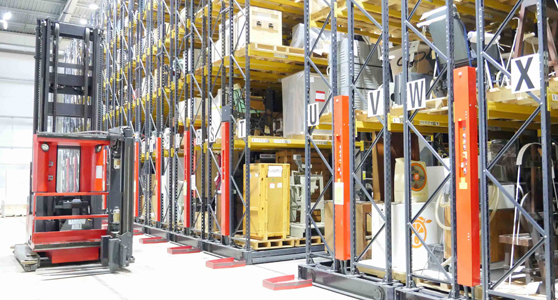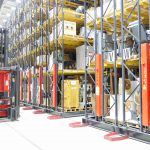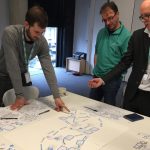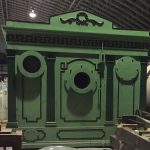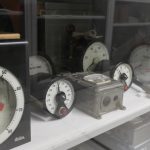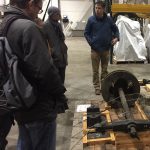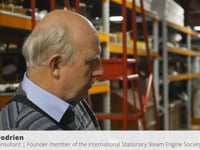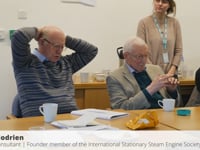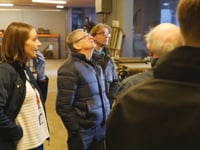Mobilising the Energy in Store: stored collections, enthusiast experts and the ecology of heritage
Abstract
https://dx.doi.org/10.15180/191207/001In this multi-media article we examine the experiences and perspectives of a group of enthusiast experts as they encounter the collections held in store across the Science Museum Group as part of the Energy in Store project. Their voices are reflected here from observations during the project, from initial participant interviews and from filmed interviews conducted towards the end of the project. Enthusiast experts in this context often include former professional engineers, model builders or even inventors, who have detailed knowledge and practical skills that are vital to shedding new light on the collections. This group are stalwarts in volunteer museums and heritage networks across the UK and internationally. However, previous research has indicated that in recent years this audience has not necessarily been seen a priority for museums.
This article views the role of enthusiast experts as object ambassadors that, through their specific research practices, knowledge and understanding, help reinvigorate stored collections and can be seen as essential actors in the ecology of public heritage. We consider what form their object research takes, using a relational framework to consider enthusiast experts’ epistemic practices. From this perspective, the article argues, it becomes clear that the group are an under-utilised resource, who have important contributions to make to the dynamism and sustainability of stored museum collections.
Keywords
Ecology of Heritage, Enthusiasts, Object Research, Relational Museum, Science and Technology, Stored Collections
Introduction
https://dx.doi.org/10.15180/In the Science Museum’s storerooms in Blythe House, London, Dave is looking at an object he has been curious to see for some time. The object, a lathe, run on an engine, is one that he himself hopes to reproduce in his workshop.[1] As Dave examines the lathe, his gestures draw connections between its working parts. His understanding of the machine, how it functions, and how you would use it to craft new objects is built on a lifetime of making. Since childhood machines have fascinated Dave. He has built a profession as a scientific instrument maker from this interest, and is able himself to work in metal, wood and leather, as well as to work with electronics. He is expert in contemporary, as well as now rather unusual, historic techniques. Under Dave’s eyes, the lathe is far more than an inanimate object. His expertise allows him to ‘read’ from the lathe itself: he can see how it was designed, how that design was corrected during production, and the marks of its use. He knows the trades involved and can intimately imagine the life of the artisans who manufactured it.
Between July 2017 and July 2018, Dave joined a group of other independent researchers in Energy in Store (hereon referred to as EiS). This collaborative project brought together a small working group of curators and ‘enthusiast experts’ (see next section for further discussion of this term) for a series of conversations and site visits to the stored collections of the Science Museum Group (SMG).
SMG, as most museums, have the greater part of their collection in storage. Their collections are huge, encompassing more than 425,000 objects.[2] Up to ten per cent of these are currently on display with some objects on loan to different organisations. Nonetheless most of the collection remains in storage for the foreseeable future. In their original life, museum collection items were embedded in social, cultural and technical contexts. Once preserved in museum storage facilities, they appear to be ‘at rest’.
It has been shown that this idea of the objects as ‘resting’ may be misplaced. Objects, whilst in storage, retain aspects of earlier ‘networks’ from which they arrived in the collection (Hill, 2006), and can become associated with new narratives, see (Guerrini, 2003). They also require active maintenance to remain ‘static’ (Reeves, 2017). However, in order for collection items to maintain visibility outside of the four walls of their storage facility, the objects require mediation and, more particularly, ambassadors. Unless these mediating relationships are nurtured, an object’s ‘biography’ is in many senses paused or ended when it arrives in the sterile storage environment. Some attention has been given to museums as a conduit for relationships between objects and communities (Alberti, 2005; Gosden and Larson, 2007; and (Geoghegan, 2008) on enthusiasts). The political and ethical aspects of this question as it concerns cultural ownership and authority have received particular attention (see for example (Henare, 2005; Simon 2010). To date less attention has been given to the practicalities of conceiving of and managing stored collections as bundles of potential relationships and this is an aspect we aim to draw attention to here.
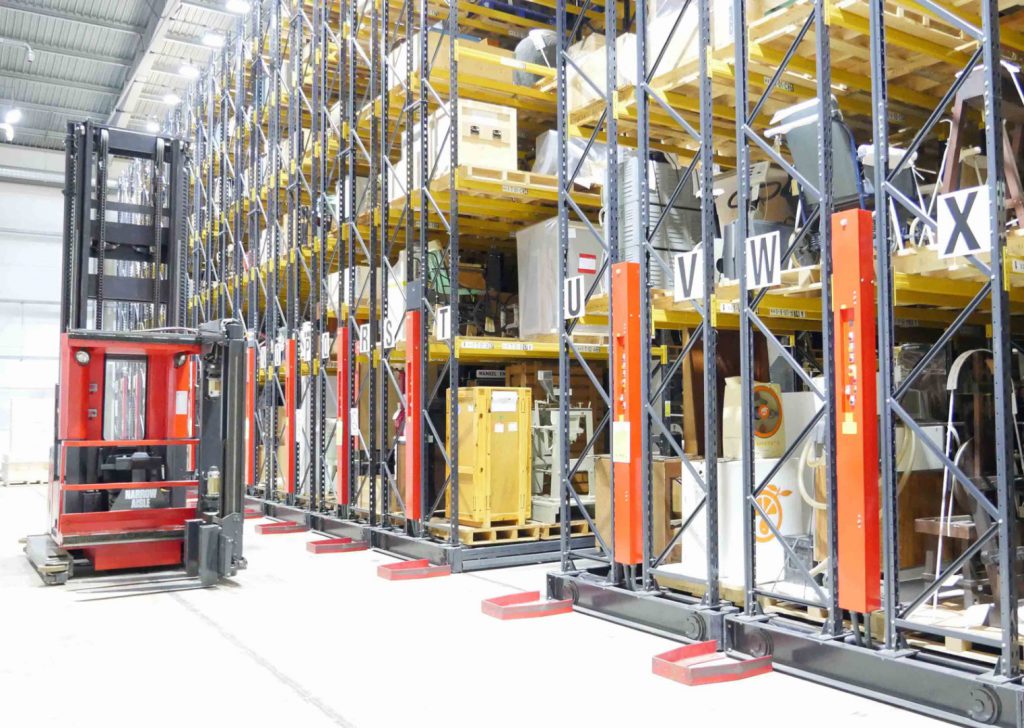
What might it mean to facilitate access to stored collections that are seen in this way for their potential to develop latent relationships? Returning to Dave, as an ‘informant’, he holds important tacit knowledge about tools and machines in the collections. Additionally, however, he plays other vital roles in ‘enlivening’ the stored collections by imaginatively and practically building relationships between the objects and other contexts. Dave belongs to specialist discussion forums whose members exchange notes, and practical advice; he connects the collections to national and international communities with specialist knowledge, embodied practical knowledge and manual skills. Through Dave’s work today, in the design and manufacture of scientific instruments, he bridges past practices with contemporary cutting-edge science, training new generations of designers and makers of finely tuned tools. More speculatively, this intangible heritage and understanding of materials and techniques is transmitted to the next generations as a potential resource to manage the present and future, including the environmental crisis of the Anthropocene (Carr and Gibson, 2016). With an ‘enthusiast expert’ as their ambassador even objects which remain physically in storage can be given new leases of life.
These connections offer the museum the potential to engage new audiences, create new meanings, and augment the cultural value of their collections without necessarily increasing the quantity of objects. This has huge benefit for the national and international significance of the collections, in terms of the sustainability of collections and in how broader publics can gain intellectual and affective access to them. Yet there are significant obstacles that prevent those associations being made. We write in a climate within which the demands of individual enthusiast expert researchers can be seen as difficult to justify resourcing (Keene et al, 2008, 31). The outcomes of the researchers’ work are not often linked back to the collections, so the benefits of their activities are largely invisible, except anecdotally.
How can museums alter their practices to maximise the reciprocal benefit for both researchers and collections that comes from their encounters? How can they mobilise the potential ‘liveliness’ of the stored collections through these ambassadors? Currently, in the SMG (and we believe many other museums around the world) much of the work of nurturing and capturing the role of enthusiast experts as ‘ambassadors’ is done on an ad hoc basis, by individual members of museum staff. Those curators, archivists and conservators do invaluable work, but we suggest that this could be more systematic and more joined up. Certainly the enthusiast researchers from EiS expressed a desire to allow SMG to better harness the value of their endeavours.
In what follows we first elaborate on our use of the term ‘enthusiast experts’ before then briefly introducing the background to the EiS project. We then situate the ambitions of EiS within current debates around stored museum collections and the role of researchers. The principle foci of the article are an exploration of what enthusiast experts can offer museums, the peculiarities of their practice and the institutional value of understanding this practice. In particular we consider how defining ‘research’ more pluralistically offers insight into the effect that a museum’s policies might have on realising the relational potential of its collections. This is elaborated via four topics that arose during the project, but are not fully considered in existing scholarship.
First, we consider researchers as ambassadors between objects. Museum collections are more than conglomerations of individual objects, and enthusiast researchers are often keen to rekindle latent ‘relationships’ within and across collections. How do practices around access allow (or disallow) researchers to investigate them in this way? Second, how does museum policy relating to the physical integrity of collections shape the researchers’ capacity to forge links between stored objects and other sites, skills and practices? Third, we consider how the relationship between researchers and the stored collections is mediated through virtual access. How can digital resources allow (or disallow) researchers to explore objects within groups and rebuild relationships beyond the walls of the storeroom? Finally, we consider the role of researchers as mediators to larger social groups. How can the museum recognise the knowledge and effort that is collated within external organisations by giving greater visibility to researchers’ networks and outputs? We argue that it is crucial to consider the dynamics of these relationships when developing access for researchers, but also in building a meaningful picture of the national ecology of public heritage.[3]
Our discussion draws upon data gathered via several research methods: the authors’ participant observation during the project, including structured group discussions and mapping exercises. These conversations were facilitated by information designer and community arts expert John Wallett from Livingmaps, and recorded by Aura Films.[4] Additionally we draw on semi-structured interviews conducted with each of the participants at the start of the project and, finally, the participants’ reflections in filmed interviews conducted towards the end of the project. The video documentation allows us to share some of the conversations in the words of the participants themselves, as well as providing a richer sensorial access to the storerooms and collections under discussion.
Defining ‘enthusiast experts’
https://dx.doi.org/10.15180/191207/002‘Enthusiast experts’ was (not uncontroversially) our shorthand term for a category of researcher that is difficult to define and requires some elaboration on three counts.
Firstly, our own definition. We hold the term ‘enthusiast expert’ to define those who are committed to participating in the history of their community and advocacy for its heritage. Namely, (i) a commitment to the development of specialist historical knowledge to which they have dedicated their leisure time; (ii) a variety of practical rather than purely intellectual outcomes to their research practice; (iii) an active role as champions for the industrial and technical heritage, pursuing a range of roles from physical conservation, the management of volunteer-run collections, development of sector strategy, public engagement and lobbying.[5] Several of our group had connections to universities, but this wasn’t essential, and academic scholars were not their primary audience.
Secondly, we recognise that the term ‘expert’ is generally held to apply to someone with technical experience and social authority. There is a strong coincidence between the popular conception of ‘expert’ and the skill sets, social capital and dominant male gender of the EiS group.[6] We hold, however, that the nature of ‘expertise’ should be considered as extending beyond the domain of professionals in science and technology into diverse and more vernacular contexts (Srinivasan et al, 2010). The experience of the authors in working in heritage with groups of different genders, ages and levels of social capital, but similar commitments to their community’s heritage, suggests that the term ‘enthusiast expert’ carries well beyond the demographic profile of the group in EiS.
Thirdly, we are attentive to the politics that separate the ‘enthusiast’ from the ‘professional’. The working group participants which, as noted above, included curators, other museum staff and enthusiast experts were equal partners in the knowledge exchange process. We think this can be usefully conceptualised as a ‘continuum of practice’ (see Craggs et al, 2013), where each participant through their differing motivations, logics and activities contributes to the ecology of heritage and, in particular, how energy heritage can be ‘understood, experienced and reshaped’ (ibid, p 881). This article draws attention to this dynamic, arguing that it is productive because ‘it draws attention to the overlaps between seemingly diverse roles and identities’ (ibid, p 893).
We understand museums to be heterogenous organisations and this article focuses on one national museum context in particular. However, we recognise that in smaller, often volunteer-led museums, enthusiast experts such as those involved in EiS could easily be responsible for managing and running such organisations (see Candlin, 2016). Likewise, the SMG curators may have their own personal enthusiasms which may differ from (or are aligned with) their professional role (see Geoghegan, 2008, p 174). Enthusiast experts should therefore be seen as part of a continuum, their expertise, in this case for energy heritage, sits alongside that of a number of diverse actors whose positions on the continuum can shift and change depending on the context.
With this understanding of a continuum in mind our use of the term ‘enthusiast’ is not intended to reinforce a professional vs. amateur divide, but it allows us to recognise that some institutional practices may do so. The professionalisation of the heritage sector has created obvious disruptions to a smooth ‘continuum’ of expertise for some museums, particularly in large organisations such as SMG. For members of the EiS group this could feel jolting when camaraderie was cut short by institutional regulations that clearly demarcate forms of access, regulating and excluding enthusiast ‘outsiders’ (Meyer, 2008).
Whilst roles and practices in smaller and independent heritage organisations might be more fluid (see Candlin, 2016) national museums face a particular challenge in building productive and sustainable relationships between stored collections and enthusiast experts. This is due, in part, to the scale of these organisations. The division of labour in large museums means that stored objects bear increasingly multiple relationships even internally. Stored collections are mediated by different departments with different forms of accountability and different agendas (curators, conservators, learning teams and PR, for example) (Morse, 2018). These departments sometimes have conflicting processes and narratives. Additionally, the communities of enthusiast experts may be spread thinly over a national geography. Our attempts within EiS to map some institutional processes (see Figure 1) indicated just how hard it is to create and maintain the sociability and ‘liveliness’ of relationships under these conditions.
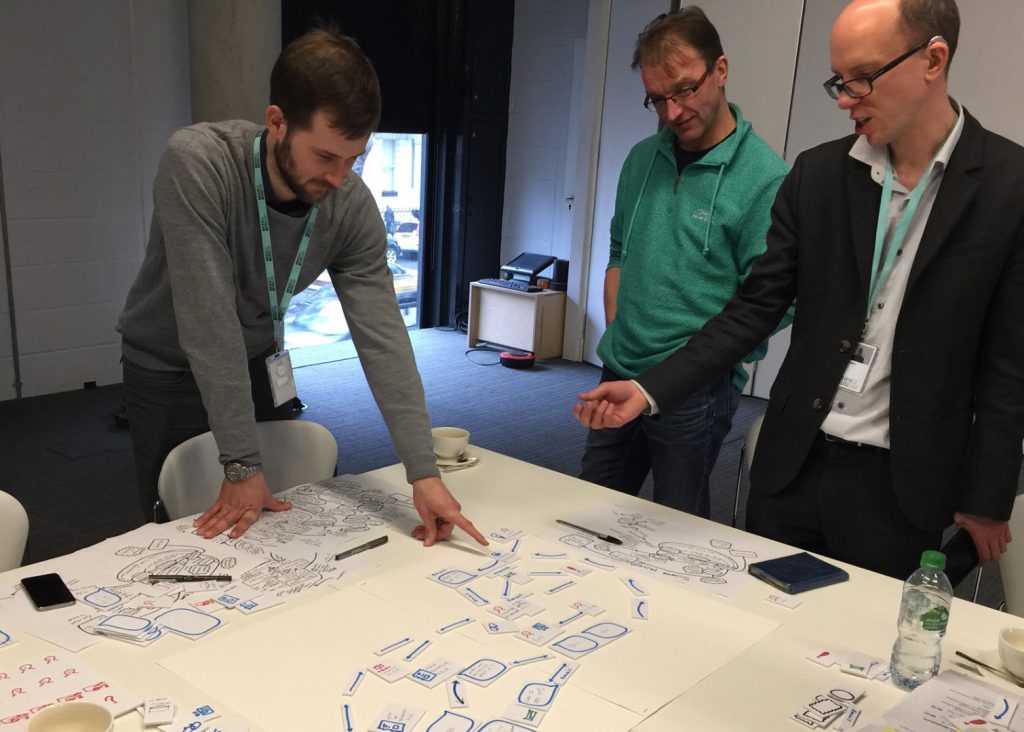
Yet despite potential barriers, in acting across and beyond institutional boundaries, enthusiast experts can be seen to be vital to the dynamism of the sector, or (as we have chosen to conceptualise it) the ecology of heritage. An earlier small-scale collaborative research project Who Cares, Interventions in ‘unloved’ museum collections had shown that there is a need to better understand how museums can meet the needs of enthusiast experts as a group which, arguably, has received little attention in recent years (see Woodham et al, forthcoming). EiS set out to redress this by putting the relationship(s) between stored collections, museum infrastructure and enthusiast experts centre-stage.
Background: Energy in Store
https://dx.doi.org/10.15180/191207/003Over the twelve months of the EiS project discussions focused specifically on stored objects that were related to the history of the technology for generating and distributing energy. These objects sit right across the SMG collections. The topic was chosen for the particular challenges that it offered. Many of the objects that fall into this category are part of large industrial systems (cables, engines, gas meters, power station panels or other component parts). They also rarely offer immediate visual interest to those without the requisite historical knowledge. Many of the objects would generally be considered obtuse, unattractive and dull for a general audience. For the museum, many of the objects in this category also offer logistical challenges, for a variety of reasons: some are at an architectural scale, some were removed in pieces from their former sites, many contain materials that are hazardous to human health (see, for example, the gas meter depicted in Figure 2 and Figure 3; or the engine in Figure 6). In sum, whatever records may or may not exist about these objects’ former existences their historical stories don’t sing for themselves. They require extensive mediation and interpretation to bring them to ‘life’.

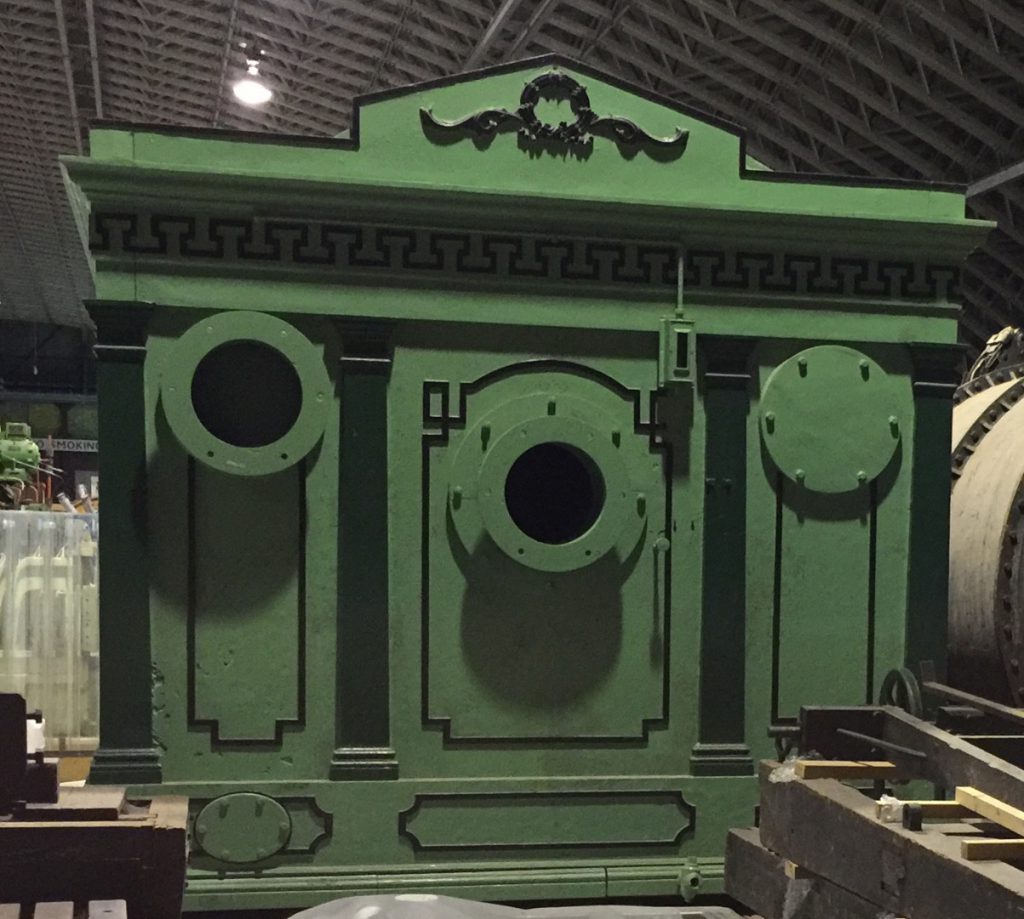
The external participants that joined the museum staff in EiS all had previous experience researching SMG collections, and long-standing research interests in the history of energy technology. Beyond these shared characteristics, however, the group had diverse reasons for engaging with the stored collections. The group included former and current engineers, industrial archaeologists, a metallurgist and a model builder. The processes and outcomes of their research varied widely. Some aspects of the group’s research might look more traditional, with an inspection of objects for details of makers or locations, which were then written into publications. For most, however, the research also had more practical methods and ends.
The project was primarily structured around visits to different SMG stored collections in London, Manchester and Wiltshire. These visits were punctuated by round-table discussions and reflections, which were continued over email and on a private online forum. During EiS we captured the details of each expert’s research practices, in particular what is sometimes taken for granted, in order to build as detailed a picture as possible of how the SMG artefacts were recorded, considered, digested and transformed, beyond the storeroom, out in the world, into new knowledge, new situations and sometimes even reflected in new objects.
Redefining the ‘use’ of stored collections by enthusiast experts
https://dx.doi.org/10.15180/191207/004The question of how researchers ‘use’ stored collections is intimately connected to the ways in which museum storerooms are conceived, within institutional frameworks and within public discourse. There has been a marked increase in interest in stored collections in the last decade. This stems in part from mounting financial pressure on museums in the twenty-first century. National museums in the UK have been asked to make a better return on their ‘capital’ and use their stored collections for displays rather than buying in shows and objects from elsewhere (BBC, 2011). Arguably this economic imperative has accelerated a significantly increased interest in these spaces from a variety of different perspectives ranging from intellectual, poetic or ethical engagements with the museum ‘store’ (Brusius and Singh, 2017; Keene, 2005), to practical assessments (Bond, 2017; Keene et al, 2008) and initiatives such as UK National Lottery Heritage Fund[7] schemes to encourage greater public benefit from museum collections (see National Lottery Heritage Fund, 2019).
In parallel, interest in the ‘use’ of stored collections can be identified in three other interrelated trends in the sector. First, an increasing interest in haptic and embodied material culture research, where stored collections are seen as more than a reserve of reference objects, but as part of sensory cultures and learning (Boon et al, 2014; Carr and Gibson, 2016; Chatterjee and Hannan, 2016; Patchett, 2008). Second, we can see an emerging interest in the material and affective infrastructure of stored collections (Cook and Cousens, 2009; Geoghegan and Hess, 2015; and Woodham et al, forthcoming). Third, and slightly more obliquely, stored collections feature as part of an interest in co-curation, and community involvement in collection interpretation and in contemporary collecting (McSweeney and Kavanagh, 2016). Although writing on museum co-production has usually focused on how ‘community’ participants experience the social and physical infrastructure of ‘the’ museum in general those processes have often brought publics into the stored collections (see, for example, Mutibwa et al, 2018).
Yet, despite increasing interest in the experience of different publics in the areas of the museum that are ‘behind the scenes’, there is, however, very little literature that would offer a considered basis for physical or social architectures that might support such access. It is recognised that museum storerooms are difficult places to navigate, both practically and conceptually (Cook and Cousens, 2009; Keene et al, 2008; Geoghegan and Hess, 2015), yet there has been very little attention given to what enthusiast experts want and need in order to do their work effectively within and alongside museums. EiS brought the enthusiasts, curators and conservators into dialogue to explore the ways in which they perceive how museum-stored collections (do/could/should) function as a resource.
The lack of detailed descriptions of the nature and the range of researcher practices that are being brought to museum-stored collections is disturbing given the levels of investment being made into resource design that may not suit their needs at all. This is especially important where museums are looking to find forms of digital mediation of their collections (Discovering physical objects, 2008). How can a museum’s digital mediation extend and complement the research styles, goals and achievements of this key constituency and their communities of practice? EiS, based on ethnographic observation and community mapping (rather than survey or interview), offered a nuanced view of these issues, one that might inform better decision making.
In relation to UK institutions, the question of how researchers use collections in storage has been mapped in two key studies. A first study, published by the Research Information Network, UK (Discovering physical objects, 2008) offers an in-depth description of researcher practice, and contrasts researcher expectations and museum capacity. This report focuses, however, on academic researchers, and assumes the primary outcome will be academic publication. The practices of this group do not fully map onto those of the enthusiast expert, for reasons that we outlined above.
A second study (Keene et al, 2008), considers a broader range of researcher types and offers a categorisation of how different publics might encounter stored collections. Their key differentiation is by the level of user engagement. According to Keene et al (2008) collections are ‘conserved for everyone’, ‘visited by many’, ‘inspiration for some’, and offer ‘a pivotal experience for a significant few’. Although this report suggests that these different forms of engagement require different support from the museums themselves, what this might look like is only given by indicative examples of good practice. The enthusiast experts who participated in EiS would situate themselves in the last of these categories, although the expression ‘pivotal experience’ belies the levels of commitment, skill and knowledge that the researchers themselves bring to such moments from decades of personal endeavour. They are conceived as largely consumers of a resource.
So although Geoghegan (2008) offers a more detailed analysis of how stored collections can be made more available to enthusiast experts[8], in current literature there is a distinct lack of consideration of the role of enthusiast experts as actors in the broader ecology of the heritage sector. This is significant because despite a vibrant interest in increasing access for enthusiast experts into stored collections there is an apparent conflict with other commitments museums are making. The author of today’s museum research enquiry is, in principle, someone from the street with no particular credentials. In practice, however, gaining direct personal access to museum objects requires a great deal of social capital and cultural knowledge. In times of straitened resources for the heritage sector, bespoke access for a relatively ‘elite’ group could be seen as reinforcing existing inequalities. It may be difficult to prioritise ‘pivotal experiences’ for a ‘significant few’ where museums have the ambition to serve broader and less elite audiences (see Keene et al, 2008). Considerations around enthusiast expert access must be read as part of broader discussions around austerity and the complexities of conducting research in this context, viewing the heritage sector as an ecology connects policies, practices and the personal reflections of participants to much wider debates (see Hall, 2017).
For this reason, however, it is important to see independent enthusiast researchers as more than consumers of museum resources, and to properly characterise their role. The EiS group (loosely conceived) stimulate the general vitality of the sector. However, understanding their contribution requires a holistic perspective that takes into account diverse forms of value, and includes an understanding of the success of the heritage sector as relational. The return on enthusiast expert work is not measurable within a single institution (as would be, for example, the contribution of a volunteer). Many enthusiast experts use more than one collection, engage across several sites, bring multiple skill sets and interact with diverse communities. How can this active bridging role be recognised and harnessed effectively? How can museums positively intervene to support the activities of the enthusiast expert as ambassadors and the efforts to carry learning, enthusiasm and contextual knowledge between stored collections and to new sites where the objects make ‘sense’. The discussions in EiS allowed us to begin to sketch out those dynamics, as well as to consider how museum policies might constrain or nurture this potential.
Finding your joy: activating latent relationships within and across collections
https://dx.doi.org/10.15180/191207/005To date access to objects in stored collections has mostly been described as a means to dramatise the ‘process’ of what museums are and do, to open up ‘behind the scenes’ to the view of a general public. In Caesar (2007), this is described in the trope of ‘treasure trove’; for Bond, a means for institutional magnitude to inspire ‘wonder’, or the affective sensation of ‘discovery’ (2017).[9] From certain quarters in the Science Museum staff opening the storerooms was seen as a more-or-less superficial aesthetic (unproductive) experience. Discussion with the enthusiast experts in EiS would lead us to concur with Reeves (2018) that an important secondary aspect of this spectacle is an opportunity for visitors to ethically engage with the philosophy and museum staff labour that underpins museum collections. However, the enthusiasts also made it obvious that for them accessing the collections in the storerooms rather than in separate study areas offered epistemic advantages. That is the focus here. The practices through which enthusiast researchers might take advantage of the possibilities offered by browsing in the storerooms and build connections within the collections are, we suggest, indicative of the ways in which they augment the value of collections, beyond the store.
Stored ‘collections’ as an epistemic access point
If seen from the point of view of the general visitor, as Keene et al (2008, p 65) suggest, the dense typological arrangements with little or no interpretation might not be appealing. The lack of labelling to explain and mediate is usually seen as a barrier for appreciation by the public. The standard mode for overcoming this barrier is the store tour with a curator who can provide live interpretation (Bond, 2017; Caesar, 2007; Museums Association, 2005, p 11). Yet for visitors with specialist knowledge, and a basic understanding of the storage system, the lack of a narrative overlay is appealing, rather than intimidating. That absence makes it easier to focus on the details that relate to their specialist interest. Access to the collections in storage also offers up opportunities for serendipitous encounters with objects (Bond, 2017; Mutibwa et al, 2018). That pleasure in serendipity was observed by the EiS group. Bert Wraith described how he came across a key object for his research, not through specific enquiry but as he was walking through the storerooms of Swansea Museum. Chris Hodrien described it as the ‘joy of falling over stuff’.
Yet the researchers in EiS articulated something else than pure serendipity, in fact a kind of epistemic practice. What they described was an open-ended moment in research before the stage in which specific enquiries emerge. This moment relies on access to several objects at once, and the opportunity to consider the objects as/in families. There is a strong sense in which this moment of free-ranging, informed gaze benefits very specifically from seeing the objects in their physical form, in groups (Woodall, 2016). Providing access to the objects as collections, rather than as a series of individual (and isolated) snapshots in a study room offers an imaginative access to the objects, as communities of objects which is enormously beneficial to enthusiast expert research practices (see Figure 4).
The experience of walking around a dense typologically arranged collection for those who have worked physically and closely with similar objects is not immediately one of narrative, a diachronic relationship, that describes social, cultural or technological evolution. It is a synchronic experience. Parallels can be made to the way that library users might use the particular access offered by open-shelving as an epistemic resource (Mann, 1998). Mann highlights that scanning across titles (or in our case objects) allows you to deploy ‘recognition’, an important tool that is not available from very directed searches. As you look over the shelving you can assess objects and compare them, very easily, for example, by scale. This can be done working from written measurements, but the process is much less intuitive. You are also able to compare objects using criteria at a level of detail that is very unlikely to be catalogued, for example, wear on one object related to another. Analysis of these characteristics in objects could be calculated by comparing images, but only with investment in the creation of very high-quality sets of image data. The same epistemic process operates relatively cheaply and intuitively in situ.
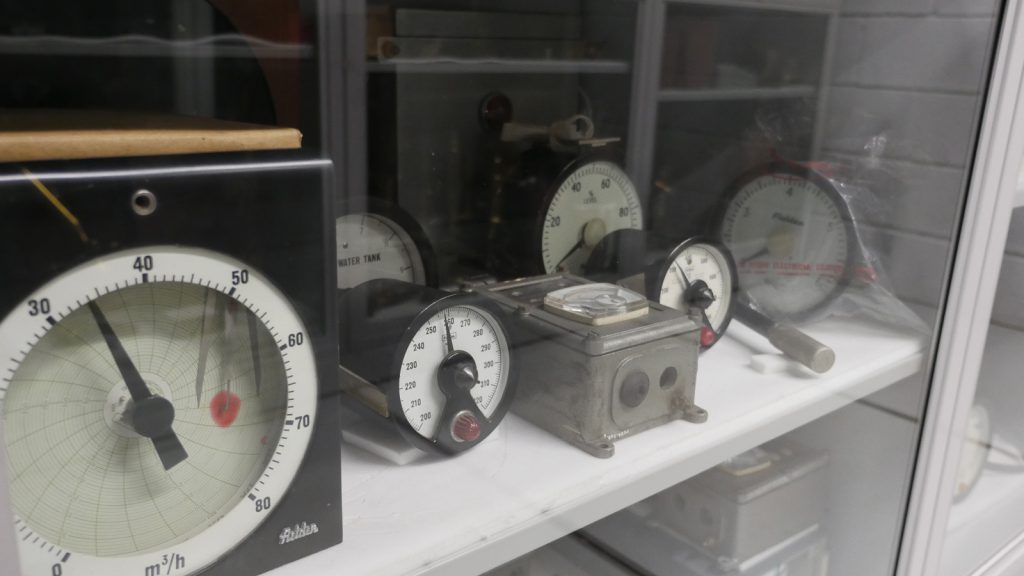
This mode of access also allows researchers to recover historical information that is revealed by identifying earlier logics of grouping. As Washburn (1990) calls them, the ‘native’ categories that have been disguised or effaced in later curatorial categorisation. Juxtaposition, in itself, can reveal the stratigraphy of a collection: ‘the sequences of exchange’ and ‘vestiges of past lives and social relations’ through which it emerged (Henare, 2005, p 9). EiS participants described these hidden groupings in different ways, depending on each individual’s interest. For some they included the techniques of an object’s assembly, for another its material at a molecular level. As is evidenced by their testimony, seeing objects in bulk allows enthusiast experts to imaginatively reconstitute those earlier logics even where they have been eliminated for space optimisation purposes.
It is of particular interest that here, in drawing the connections and comparisons between the objects, the enthusiast experts were deploying many different kinds of sense-making capacities, particularly the haptic. When looking at dismembered turbine blades, to take one example, one researcher was imagining the blades in action, assembled in a casing, acting with the flow of air or water, in comparison to a career’s worth of similar instances of motion and resistance. From this we see that this kind of access allows the researchers to fully realise, within their research practices, the experience that they themselves embody.
Whilst this kind of haptic knowledge and understanding is often difficult to verbalise, the researchers in EiS shared a common understanding of the role haptic experience plays in the transition from vague impressions into conscious new lines of enquiry, articulated by the group as ‘lightbulb moments’. It is a form of knowledge-making, which is particular to those who have accumulated decades of embodied knowledge. Whilst this experience (to return to Keene et al, 2008) belongs to the ‘few’, who might have ‘pivotal moments’, those moments are instances which offer unique opportunities for the collections to gain significance (which can then in turn be transmitted to new audiences) in a deeply sensorial register. Whilst we (and the project participants) acknowledge that visible storage is not easy to resource it is unparalleled by other forms of experience. We would advocate that the value of stored objects is increased by understanding of their relationships, and that this should be an important consideration for designing forms of collections access.
Researchers linking collections to each other
Related to the issue of building connections within collections is that researchers are building up an understanding and research practice that bridges across collections. Through their research the EiS group were generating connections between different sites (contemporary communities of practice, and preserved industrial architecture, as well as other museum and archive collections). Although collections mobility is usually understood with regard to object loans and physical location, the imaginative activation of connectedness between stored objects and external locations allows for a less onerous form of mobility. To take one example from EiS, this might be a sense of how a technological system can be imaginatively ‘returned’ to a former social context. Chris Hodrien described how engines feature in his historical imaginary: ‘My specialist steam engine group ISSES [International Stationary Steam Engine Society] always prefer that engines are demonstrated in their working environment, that you preserve the complete thing, because what’s important is not just the engine, it’s “what does it drive?”. If you take it away from what it drove, you’ve lost half the story.’ For Chris an engine is best understood in relationship to the work it accomplished in the world, and his research rebuilds those links. For Ian West, an industrial archaeologist, the work of re-associating objects with their former locations and social history was the raison d’être of his relationship with SMG.
This might, however, be a more multidirectional process of reconnection. In another example from EiS, Geraldine O’Farrell recounts her studies of two very early buildings with electrical fittings (Cragside, Northumberland from 1863, and John Rylands Library, Manchester, from 1900).[10] She offers up yet a further sense of how specialist historical knowledge is cumulative across objects, sets of objects and sites, and deploys ‘recognition’.
I went up to National Trust’s Cragside and I was there to give professional advice and got talking to one of the archaeologists…he presented me with two sections of different types of early trunking. You know what trunking is? Trunking is often flat, box-like, that sits on a wall or in a wall, that takes cabling.
…he gave me two samples of early wooden trunking. Usually, they’re made out of metal or plastic. So, these were my little gems that I kept and studied for quite a while.
[…] What I saw was a pattern between Cragside and what I’d seen at John Rylands. At John Rylands, everything is [on the] surface. The trunking is identical to what I’d seen at Cragside, only…made out of brass.
Usually research access to collections has, we would argue, largely been conceived as a relationship between a researcher and an individual object. The discussions from EiS around how the enthusiast experts conceive of and use the storerooms suggests a more holistic approach would provide a better platform for their work. The EiS researchers draw on and contribute to understandings of collections in storage by multiplying relationships and meaning within and across institutions, thereby enriching the ‘ecology’ of industrial heritage. This possibility may only be open to an informed few, but those few are able to increase the significance of objects and allow others to see the collections anew from alternative perspectives.
Stored collections and researchers as ambassadors of intangible heritage
https://dx.doi.org/10.15180/191207/006‘Practitioner’ requirements for access
Many of the enthusiast experts who participated in EiS had active professional engagement in contemporary technical practice, materials and systems. This often manifests in a desire to explore the collections ‘actively’ by handling them, i.e. putting tools or machines to use, mending them, deconstructing or reconstructing them. Their professional biographies, and the fact that they hold specific professional skills and know-how sometimes generates a sense of personal attachment to particular objects, which may be articulated as a sense of entitlement to privileged access to the collections. This can cause conflict with existing collections access policies, in two domains in particular. Firstly, past technical practice is not necessarily aligned with contemporary best practice in object preservation, or occupational health and safety. Access to some objects in particular may require very close supervision. Secondly, museum policies (including those for collections access) are arguably not intended to offer particular privilege to certain groups.[11] In times of straitened resources, therefore, it may seem difficult to justify the cost of investment in supervising enthusiast experts carrying out more ‘hands-on’ or interventionist modes of research (Keene et al, 2008).
We agree that it is not ethically desirable for museums to compound privilege by providing those who could be considered social elites with further means to reinforce their contemporary status. However, we need to take a wider view of what the researchers’ interventions might achieve. The group in EiS demonstrated that they embody historical continuity, as witnesses of technological change in their careers, and through their own biographical relationships with their predecessors. In doing so, the enthusiasts bridge between historical technical objects, contemporary technical practice and future forms of making and material. This exemplifies the ways in which researchers act as ambassadors, allowing objects to ‘travel’ into new forums and act as a resource in as-yet unimagined ways. Recent literature has highlighted the role of skill and apprenticeship in the transmission of technical cultures through changing social contexts (Carr and Gibson, 2016; Patchett 2008). Enthusiast experts practices are potentially hugely beneficial to the museum where they connected stored objects to new futures in multiple dimensions. Two particular examples from EiS bring that to the fore.
In 2016, Bert Wraith was granted permission to drill a hole in a historical metal sample, part of a set of chemical materials that were collected by a nineteenth-century metallurgist.[12] His request to make this rather radical intervention was driven by his investigation of the evolution of methods for extracting pure copper from ore. He had identified a sample in the SMG collection that was of particular interest. Bert is a metallurgist with decades of experience. He was able to use his contacts in the contemporary metal production industry to arrange a laboratory assay of the historic sample, using cutting-edge assay technologies. Bert’s access to that equipment had direct benefits for SMG. It enabled SMG to learn important new data about that particular sample, but also generate new ideas for methods to test historical metal samples that are of great utility to the heritage sector more broadly.
A second example sees a slightly less direct way in which this ambassadorial role can play out. Dave Clark, in 2018, was granted permission to measure (which meant careful handling of) several dismantled pieces of a historic steam engine. This was a stage in a longer-term research project that requires the careful comparison of steam engine blueprints with the finished engines.[13] Through his research Dave has gained a great interest in, and respect for the historic profession of a ‘fitter’. The ‘fitter’ adjusted engineers’ designs in the process of construction and was the missing link between ideas that were ‘good on paper’, to working machines. Much of his historical investigations turn around a sort of ‘reverse-engineering’ of the work that fitters once did. This interest in fitters informs Dave’s relationship to the young apprentice scientific instrument makers that he trains in his current employment. Dave’s learning from historical production practices feeds into his mentorship of those young engineers who are learning to anticipate the failings of computer modelling in relation to material manufacture. From both of these examples it is clear that the enthusiast experts’ particular professional contexts and skills make the stored objects ‘live’ in ways that would otherwise be difficult to imagine or achieve.
What needs to be reconsidered around this kind of access? One issue, we suggest, is a reconsideration of what is considered as a valuable outcome of a research ‘intervention’. Typically this value would be framed in questions about the research enquiry itself (new knowledge), research outcomes in publication (new readership), or the transition of the object to new locations (new audience). We suggest that if decisions around value/cost of supporting these interventions are tied only to these criteria, then they are too narrow. In both Bert and Dave’s cases, answering the specific research question with which they originally justified their interventions, and even publishing their results represents only a fraction of the value that their investigations rendered.
Arguably Bert and Dave’s research interventions on the stored collections engaged their contemporary professional communities, and in doing so revitalised the relationship between objects and the outside world. The ‘liveliness’ of these social connections offered substantial reciprocal benefits – that went beyond the private satisfaction of the individual researchers, or the direct research interests of a niche group. Their research interventions on the stored collections offered long term and complex forms of benefit to their professional communities, and the museum, increasing the resourcefulness of each. We argue that conceiving of heritage as an ecology, and framing the enthusiast experts’ interventions as beneficial to that wider environment, might provide a key to acknowledging that value.
Ordering and structuring digital collections
https://dx.doi.org/10.15180/191207/007EiS revealed a number of complexities surrounding ‘real’ and ‘virtual’ access to museum collections for enthusiast experts. With the inclusion of an online collections database accessed via a museum’s website becoming increasingly expected, especially for larger organisations, the use of these digital catalogues as a research tool for enthusiast experts perhaps unsurprisingly became a central focus for discussion.[14] The availability of collections information online (with varying degrees of sophistication) has been a priority for museums since the mid 1990s (Chapman, 2015), encouraged by funding streams offered by the former Heritage Lottery Fund (in the UK) for example, and by national and international level aggregator projects such as ‘Culture Grid’ and ‘Europeana’ to name a few (ibid).
Despite being a common feature of a museum’s website, not all of the EiS participants were aware that it was possible to search SMG’s collections online, indicating that there is still some work to do around increasing awareness of this potentially rich source of collections information for specific groups. Museums should not expect that just because they have invested in online digital resources that this is enough to ensure their usage. However, there was wide agreement amongst the EiS group over the potential value of online collections information in terms of facilitating their own research practices. For example, in the following video clip, Dave, Jane and Chris discuss their use of SMG’s online catalogue, highlighting their experiences of using this way of searching the collection and pointing out some of the issues they came across.
Our discussions around accessing online collections information to a large extent mirrored discussions elsewhere (e.g. Coburn, 2016) around the difficulties of using online search interfaces, particularly around finding specific objects among the ‘abundance’ of information contained within the database (see Whitelaw, 2015) and also the quality of the information returned. However, where these discussions potentially differ is around the failings of online collections information to meet the needs of the specialist audience. For SMG, and no doubt other museums, the quality and quantity of information within their online catalogue is a changing picture as more records and photographs are added, increasing its usability. This ‘work in progress’ nature of online catalogues was acknowledged by the EiS participants; however, some expressed frustration at not being able to find specific objects they knew to exist in the museum’s collection using what they considered to be very straightforward keyword search terms. This discussion revealed again that while collections information might technically be available in an online catalogue it can remain ‘invisible’ if it is not clear how to search for it effectively. Enthusiast experts are often equipped with an in-depth technical and historical understanding about specific parts of a museum’s collection and will be using search terms which reflect this knowledge base. However, if the internal ‘logic’ of the catalogue is not clear, then they are unable to resolve the difference between their own use of terminology and the data held by the catalogue.
During one of our workshops we discussed how ordering search results by the relatively opaque category ‘popularity’ buried key objects many pages into the list of results. Ordering search results by popularity may be a useful and accessible mechanism for general ‘non-specialist’ users, as the search results prioritise ‘iconic’ objects. However, for enthusiast experts whose interest lies in specific objects that often go beyond the star items in a collection, this ordering system was unhelpful and frustrating rather than enabling.
This discussion raises further questions around recognising the variety of different values associated with the objects in a museum’s care depending on the user and how these impact upon the way information is ordered, structured and presented. Ordering search results in the SMG catalogue so that they appear with an internal logic which aligns both with the expert user and the general user’s needs and expectations is possible. However, success relies on knowing how to do this using the search tools provided. Without adapted guidance on how to order and refine search results the collections remain only partially discoverable. This finding may not be generalisable across museums as a whole. For example, the Victoria and Albert Museum (n.d.) provides detailed guidance on how to search the collections and refine and order the results, and research conducted on the British Museum’s ‘Collections Online’ database indicated that academic users were able to use a variety of different and sophisticated search strategies to find information (Ross and Terras, 2011). It does, however, indicate a gap in this case in understanding how digitally-mediated collections information works for and meets the needs of this specific expert audience.
The requirements of the enthusiast expert group also extended to the information contained within collections records and the structure of the underlying collections database. The usability of online collections records by this audience group could be greatly improved if the database structure was more relational, allowing for a range of different groupings and associations to be recognised. Currently it is possible to link objects by maker, place of use, or manufacture and by historical associations. The EiS group were keen to understand more about objects’ histories within SMG. For example, if an object had been in an exhibition, what other objects had also featured? What text accompanied the display? We discussed above the benefits of the epistemic practice of browsing within the physical storeroom. How could these practices be more satisfactorily enabled in a digitally mediated environment? The online environment may offer a more feasible way of linking objects by type, but also potentially by a whole range of different and unexplored associations that is not feasible through physical access to collection items in store or in a study room. This would potentially aid further avenues for ‘relational exploration’ by enthusiast experts and increase their capacity to act as ambassadors between other sites and collections.
It is not difficult to take this one step further and envisage a fruitful link between this particular expert community, online collaboration and the co-creation of collections content in the digital world (see Ridge, 2014). We have argued throughout this article that enthusiast experts could be viewed as object ambassadors, as connecting points linking geographically-disbursed knowledge from across their own professional expertise, networks (as we will discuss below) and wider connections, past and present. There is huge potential to channel this expertise back into the collection, to connections and capture the interaction between enthusiast experts and stored collections that the ‘relational museum’ (Gosden and Larson, 2007) requires. The digital world surely offers a mechanism for such a relationship to be nurtured?
The enthusiast experts’ familiarity with specific types of collection, built up over many years meant for some the information presented in online catalogues held even greater significance as material which could facilitate their research. The importance of being able to come into physical contact with the object, to understand it in a more haptic and sensory way was essential to decode how the object was used and to understand its meaning and significance. However, the level of expertise and confidence with the material demonstrated by some enthusiast experts meant that if the information presented online was of sufficient quality, a physical encounter with the object was not always deemed necessary. While the EiS group was a small sample of individuals, the discussions demonstrated that it should not be assumed that this expert audience group always needs to see the objects they are researching if the information available online is comprehensive enough.
What understanding this means, however, is that museums do need to be aware of what types of information have most potential value to the enthusiast expert. During our discussions it became clear that what constituted ‘important information’ often went beyond that contained in most descriptive object catalogue records, and extended to the archival information and documentation museums hold about their collections. This specific kind of archival information is often paper-based and ephemeral and could include, for example, conversations from present and former museum staff, earlier research conducted around the object, or information accompanying the object upon its entry to the museum. This is the type of information that would typically be kept in a filing cabinet in a curator’s office or, depending on the organisation, in a more formal structured institutional filing system. This information is essential for understanding the object’s context and changing meaning over time. and importantly for seeing the object as something with a dynamic and ongoing biography (which this article argues for), rather than as something static and fully removed from its former context. Jones (2015, unpaginated) explains how this ‘networked knowledge’ which incorporates both the object and a range of different documents about the object ‘remains elusive’ (ibid). This is in part due to the fact that collections management systems and systems of archive management often lack integration with each other. Especially, we would add, at the level of institutional records or ‘grey knowledge’ (see for example Swinney, 2012, on museum registers).
Digitisation projects have tended to prioritise descriptive information about the physical appearance of the object and photographs of the object rather than this additional institutionally-gathered archival information. Therefore the SMG online catalogue does not necessarily refer to other repositories of information held about the objects which exist in the museum. Currently, this information will remain invisible to the enthusiast experts unless it is bought to their attention through an interaction with museum staff. It should be acknowledged that this documentation is unlikely to have been gathered with open access in mind, therefore although the inclusion of ‘networked knowledge’ in future documentation projects seems vital, as is already happening in some organisations (see Shepherd, 2017), there is work to be done to understand what can and cannot be ‘put online’ so that museums can ensure they adhere to legislation and regulations around data management.
In sum, the EiS discussions highlighted the importance of better understanding the research practices of enthusiast experts as important stakeholders in museum digital cataloguing projects. The group were very aware of the ways in which digital technology itself might increase the visibility and value of the stored collections, and very keen to contribute where they could. The enthusiast experts themselves offer both knowledge and manpower in augmenting the richness of the connectivity within the digital catalogue, and from the catalogue to other resources. Digital technology offers a great opportunity to amplify the work of this group, if their needs are well considered.
From networked knowledge to knowledge networks
https://dx.doi.org/10.15180/191207/008A final aspect of research practice that was considered by the EiS group was the importance of sociability and collaboration. The emotional engagement inherent in enthusiasm and the sociability displayed by enthusiast groups (Geoghegan, 2013; Woodham et al, forthcoming) is perhaps under-acknowledged by museums. Although the EiS project focused on knowledge exchange across a small participant group, the participants were informally connected to a range of different geographically disbursed interest groups. This included the Newcomen Society, the Association for Industrial Archaeology, the International Stationary Steam Engine Society, the Heritage group of the Chartered Institute of Building Services Engineers, connections with contemporary industry and many more.[15] These groups play a variety of roles, sharing information, building historical knowledge sets, heritage advocacy, and practical engagement in heritage conservation. They represent expertise, enthusiasm and capacity that the museum might draw upon. The network of social and professional relationships indirectly connected to the museum through the EiS reinforces the idea that a museum, as Gosden and Larson (2007, p 4) suggest can be viewed as ‘…an aggregation of people and things that stretches beyond its immediate physical confines’, connecting thousands of relationships over time between people, places and objects.
This was expressed within EiS working group in slightly different terms. Nonetheless the group were clear about the benefits of having the right experts in front of the objects in terms of understanding the object. A curator in the following clip describes this process as a ‘triangulation’ of knowledge, and the physicality of that process is made vivid by the shots of pointing and diagramming in space during the project visits to the storerooms.
As suggested above, the potential benefit for SMG that is represented by enthusiast experts themselves, their research outputs, and their wider networks is obvious. Yet accessing this knowledge is not always straightforward. Towards the end of the ‘Stored Collections’ clip (see above) Bert Wraith suggests the enormous value the museum could realise by connecting the research done by enthusiast experts back to the object records. At SMG, as many other museums, such a request is made to researchers in advance of their use of the archives and stored collections.[16] However, it is a difficult request for museums to enforce as they rely on the researchers themselves to feed this information back.
The project offered some tangible examples of how having people with the right kind of knowledge around the objects helps curators to understand the potential (in)significance of specific collections. For example, during discussions held around the museum’s gas meter collection it became clear in a very short space of time that everyone in the group agreed that it was not necessary for the museum to keep all of them as keeping multiple examples of the same mass produced model was not likely to yield significant benefits for the museum or its wider users. The knowledge and expertise held by these enthusiast experts proved extremely useful in this case and arguably evidence of where expertise from beyond the museum can contribute to sustainable collections management practices (see Merriman, 2008).
Like the university, knowledge production in museums is far from the preserve of the paid professional (see Craggs et al, 2013; Finnegan, 2005; Meyer, 2008). However recognising and valuing the range of knowledge producers requires a specific set of circumstances to be present within the museum. Notwithstanding discourses around co-creation and building strong community partnerships (McSweeny and Kavanagh, 2016; Simon, 2010, 2016) museums do not always understand, for a range of different reasons, the ‘networks’ that they come into contact with and the benefits of nurturing them. This is despite both the diverse resources that may be accessible via these networks (see Shaw, 2006) and the clearly articulated need for museums to have access to that external knowledge and expertise.[17]
There is acknowledgement, for example, in the Mendoza review (2017) that decreasing curatorial time and expertise presents a challenge for the dynamic curation and development of collections. The small number of Subject Specialist Networks and Curatorial Networks supported by the Arts Council and the Art Fund respectively also confirm the importance of connecting museums to the ‘widest pool of knowledge and expertise’ (Arts Council England, n.d.). When knowledge and expertise are framed as a ‘continuum’ (see above) it is clear that they can legitimately come from outside the sphere of museum professionals. However, the EiS participants recognised that the small number of funded specialist networks notwithstanding, resourcing the building and maintenance of these potentially beneficial relationships with external experts is difficult to manage in a sustained and relational way.
These kinds of informal connections between amateur and professional are potentially weak, often relying on a single point of contact between the expert communities and the museum. If the key member of staff leaves it could mean the relationship isn’t maintained or passed on to the next member of staff. The relationship between amateur and professional also needs to be ‘cultivated with care’ (Meyer, 2008, pp 48). Whereas contractual obligations and professional standards set expectations between museum professionals, for external experts and the museum these ‘partial connections’ according to Meyer (ibid) are fragile, largely based on goodwill, and they require continuous nurturing and caring. Good relationship management and the development of the resources and skills required to sustain relationships may be difficult for some museums particularly in times of funding challenges.
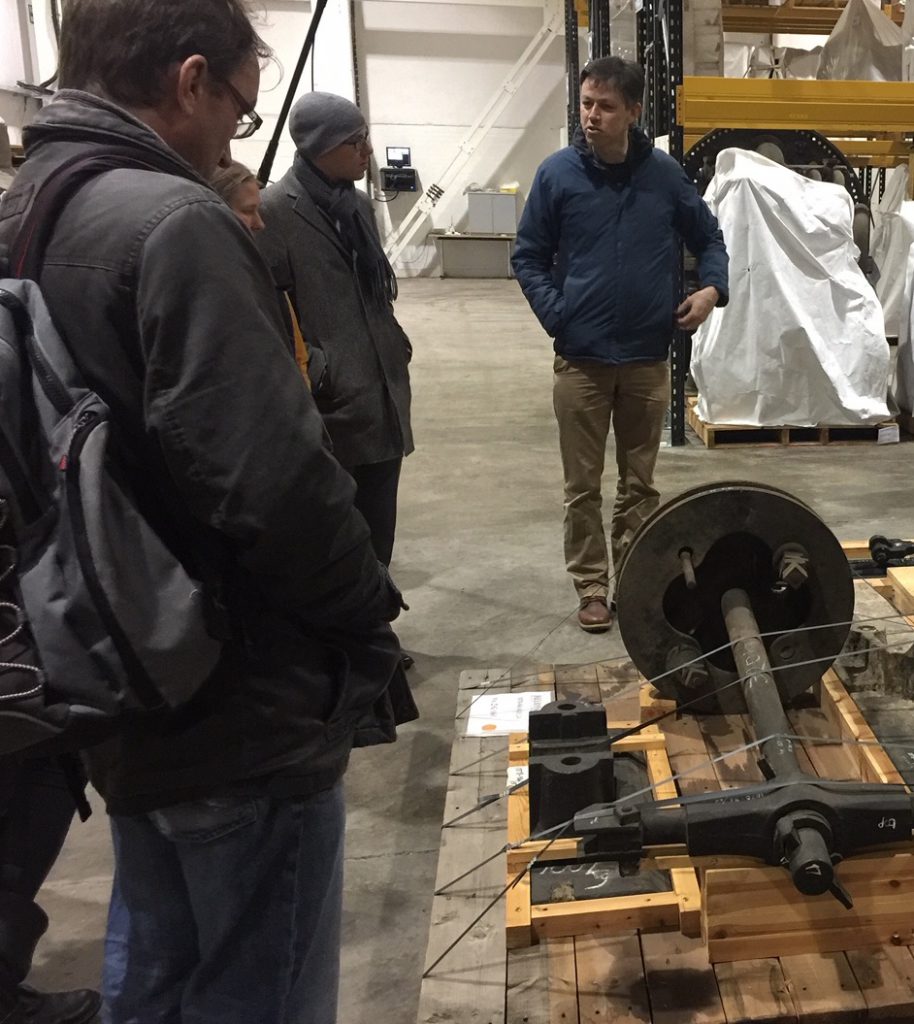
In line with Meyer’s findings (2008), EiS also highlighted the need for reciprocity, of showing that the expert’s knowledge is genuinely valued and that they feel thanked and appreciated. There was an understanding that despite the increasingly blurred boundaries between amateur and professional, museums did not always recognise that they are just one part of a wider community of practice (Wenger, 1998), which could just as easily be shaped by others. Instead there is a tendency for museums, whether this was intentional or not, to fulfil the role of gatekeeper between people and objects. This role organises permission for researchers to access objects and is not a nurturing or caring in a broader sense. Once that permission to view an object had been granted, there was limited or no mechanism to then understand the value of the knowledge and expertise that the research could feed back to the museum, if they wished.
We would strongly advocate that an ecological approach to understanding the role of enthusiast experts offer a new perspective from which to consider the value of these relationships. Although individual curators and conservators are very attentive to these, museums at an institutional level do not recognise the reciprocity in these relationships. Systematically recognising enthusiast experts as ambassadors strengthens those relationships beyond weak individual links. These, in turn, support the ‘liveliness’ of the stored collections in external contexts and builds a community that offers not only knowledge, but practical advice and advocacy for the institution.
Conclusion: stored collections and enthusiast experts in an ecology of heritage
https://dx.doi.org/10.15180/191207/009The discussions above have focused attention on the unique research practices and potential contributions that we consider enthusiast experts can make to understandings of stored museum collections. We argue that, in line with understandings of the ‘relational museum’, stored collections can be viewed as bundles of potential relationships and enthusiast experts as ambassadors, connecting objects and people across time and place. As object ambassadors, enthusiast experts are uniquely placed to deepen existing understandings of stored collections and object biographies, reinvigorating them and adding new layers of meaning through their research practices, geographic networks and connections. Significantly, our arguments have wide applicability, developing understanding of the relationships between stored museum collections and enthusiast expert communities internationally, not just for large national museums such as SMG. This will be of value to museum practitioners and policy makers grappling with how to enhance the relevance of their collections.
When enthusiast experts are viewed as the ‘…significant few’ (Keene et al, 2008), their contribution to creating ‘dynamic collections’ (Museums Association, 2018) could be challenged. Attending to their object enquires and research needs can be labour and time-intensive for museum staff who arguably could reach larger numbers through different projects. In times of economic constraints, we recognise that there are difficult decisions to be made and it may be tricky to reconcile the investment of resources on small numbers of specialist users. Yet austerity policies have challenged the UK heritage sector to reconsider and reframe ‘value’ in multiple ways and using new temporalities. When the wider ecology of public heritage is taken into account, the involvement of enthusiast experts in museums is, we argue, essential for the sustainability and on-going life of collections. Not only can enthusiast experts help to better inform organisational decision making but they can add significant value to a museum collection as a public resource without increasing the number of objects.
For a museum to fully enable the contribution that enthusiast experts offer, it needs to recognise it as a relationship of reciprocity that must be nurtured and actively maintained. This understanding necessitates the museum being open to different epistemic practices and information requirements and logics. EiS demonstrated how one group of enthusiast experts understood the SMG stored collections and wished to interact with them. We welcome further studies that consider a greater diversity of forms of ‘expert’ and offer conclusions about how museums might nourish those experts’ research practices, and extend the capacity of those experts as ambassadors.
For national museums the task of keeping a collection ‘alive’ through connections to communities is particularly challenging. These organisations are in principle serving a public that is geographically and demographically diverse as the nation. Yet in comparison to smaller and especially volunteer-run museums, their increased scale and bureaucracy make adapting to specific communities or practices more difficult. National museums therefore have an especial need to nourish their relationships to enthusiast experts; as experts, stakeholders, advocates, and as we have argued ‘ambassadors’ for the objects. That investment has beneficial returns for individual institutions in terms of short-term public impact. Perhaps even more importantly, however, is the effect that this investment would have in sustaining an ecology of heritage from which a museum’s own future is ultimately derived.
Acknowledgments
The Energy in Store project was funded by the AHRC (grant reference: AH/P013678/1). The authors would also like to express their thanks to the Energy in Store Working Group and staff from the Science Museum that took part in this project.
Tags
Footnotes
Back to text
Back to text
https://figshare.com/projects/Energy_In_Store/55673 Back to text
Back to text
Back to text
Back to text
Back to text
Back to text
Back to text
Back to text
Back to text
Back to text
Back to text
Back to text
Back to text
Back to text

